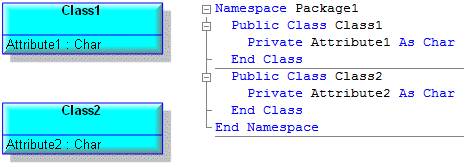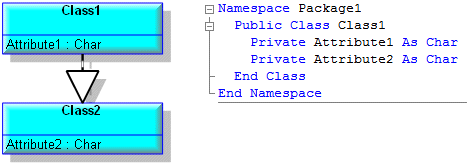Dependency mapping for Visual Basic (Visual Basic code)
ACS generates a Dependency only when its type is Abstraction or Interface Realization:
• When the Dependency type is Abstraction, the Dependency models abstraction between a class, structure, interface or module and another class, structure, interface or module.
• When the Dependency type is Interface Realization, the Dependency models that a class or structure implements an interface.
When an Abstraction Dependency links two classes, structures, interfaces and/or modules, ACS generates the dependee's members as part of the dependent's definition. When the dependee is a Class, ACS does not generate that class.
For example, for the following two Classes you can see that both Classes are declared in the generated code.

When an Abstraction Dependency is created between the two Classes, you can see that Class2 is no longer declared, but its Attribute (Attribute2) is now defined in the Class1 declaration.

ACS generates the child items, properties and tagged values of a Dependency as follows.
• A Dependency does not have any child items.
• Type property:
◦ When set to Abstraction and linking two Classes, Data Types or Interfaces, ACS generates the dependee's members as part of the dependent's declaration. If the dependee is a Class, ACS does not generate that Class.
◦ When set to Interface Realization and linking a Class or Data Type to an Interface, ACS generates an Implements statement for the class, structure or module.
◦ Other Dependency types are ignored.
All other properties are ignored.
The VB Profile does not have any Stereotypes that apply to Dependencies.